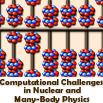Speaker
Prof.
Mike Guidry
(University of Tennessee and Oak Ridge National Laboratory)
Description
Systems of differential equations containing multiple, widely-separated
timescales are termed "stiff". It is commonly believed that specialized
implicit methods must be used to solve such systems because stability limits on
the timestep size make standard explicit integration impractical.
This talk will show that even extremely stiff sets of differential
equations may be solved efficiently by explicit methods if limiting algebraic
solutions are used to stabilize the numerical integration. Employing stringent
tests with astrophysical thermonuclear networks, evidence is provided that these
methods can deal with the stiffest networks with accuracy and integration
timestepping comparable to that of standard implicit methods. Explicit
algorithms can execute a timestep faster and scale more favorably with network
size than implicit algorithms. Thus, these results suggest that
algebraically-stabilized explicit methods might enable integration of much more
complex reaction kinetics problems than have been feasible to this point for
astrophysics and a variety of other disciplines. Recently we have implemented
these new methods on Graphical Processing Unit (GPU) accelerators for large
supercomputers such as Titan at ORNL, which permit many such networks to be
integrated in parallel. Initial tests for the Type Ia supernova problem suggest
that for realistic (hundreds of isotopes) thermonuclear networks these methods
can integrate a single network 5-10 times faster than implicit methods, and
can integrate of order 100 networks from different zones of the hydro
simulation on a single GPU in the same length of time required to integrate a
single such network using traditional implicit methods on a CPU. This implies
that many problems in a variety of disciplines such as astrophysics, atmospheric
and climate science, fission and fusion energy, and combustion chemistry that
were previously thought not possible to solve with realistic kinetic networks
may now be accessible to these new algorithms deployed on modern computational
hardware.
Author
Prof.
Mike Guidry
(University of Tennessee and Oak Ridge National Laboratory)

